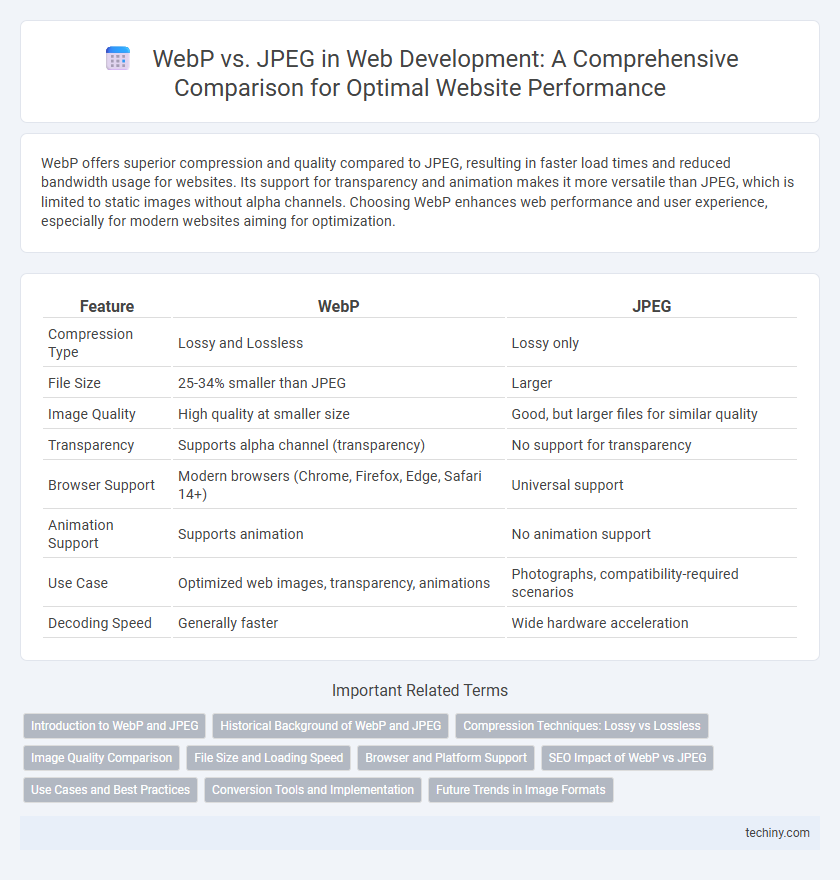WebP offers superior compression and quality compared to JPEG, resulting in faster load times and reduced bandwidth usage for websites. Its support for transparency and animation makes it more versatile than JPEG, which is limited to static images without alpha channels. Choosing WebP enhances web performance and user experience, especially for modern websites aiming for optimization.
Table of Comparison
| Feature | WebP | JPEG |
|---|---|---|
| Compression Type | Lossy and Lossless | Lossy only |
| File Size | 25-34% smaller than JPEG | Larger |
| Image Quality | High quality at smaller size | Good, but larger files for similar quality |
| Transparency | Supports alpha channel (transparency) | No support for transparency |
| Browser Support | Modern browsers (Chrome, Firefox, Edge, Safari 14+) | Universal support |
| Animation Support | Supports animation | No animation support |
| Use Case | Optimized web images, transparency, animations | Photographs, compatibility-required scenarios |
| Decoding Speed | Generally faster | Wide hardware acceleration |
Introduction to WebP and JPEG
WebP is a modern image format developed by Google that provides superior compression techniques resulting in smaller file sizes compared to JPEG while maintaining high visual quality. JPEG, established in 1992, is a widely supported image format known for its lossy compression, which reduces file size but can degrade image quality at higher compression levels. Choosing WebP over JPEG can enhance website performance by delivering faster load times and reduced bandwidth usage without compromising on image clarity.
Historical Background of WebP and JPEG
JPEG was introduced in 1992 as a pioneering image compression standard optimized for photographic content, enabling efficient storage and transmission with lossy compression. WebP, developed by Google in 2010, emerged as a modern alternative supporting both lossy and lossless compression, aiming to improve web image efficiency. The adoption of WebP has grown due to its superior compression rates and enhanced support for transparency compared to the older JPEG format.
Compression Techniques: Lossy vs Lossless
WebP supports both lossy and lossless compression techniques, providing higher compression rates and smaller file sizes compared to JPEG, which primarily uses lossy compression. Lossy compression in JPEG reduces file size by discarding some image data, often leading to quality degradation, while WebP's lossless mode preserves original image quality without data loss. This makes WebP a versatile choice for web developers aiming to optimize image loading speed and maintain visual fidelity across various digital platforms.
Image Quality Comparison
WebP offers superior image quality compared to JPEG by using advanced compression algorithms that maintain higher detail and sharper edges at smaller file sizes. While JPEG compression often results in visible artifacts and color degradation, WebP supports both lossy and lossless compression, preserving image clarity more effectively. WebP also provides better transparency handling, making it a preferable choice for web developers aiming to optimize performance without sacrificing visual fidelity.
File Size and Loading Speed
WebP offers significantly smaller file sizes compared to JPEG, reducing image weight by up to 30-50% without substantial quality loss, which accelerates page loading times and improves overall user experience. Faster loading speeds achieved through WebP images contribute to better SEO rankings and lower bandwidth consumption on websites. JPEG files, while widely supported, often require higher compression ratios to match WebP's size efficiency, resulting in noticeable quality degradation and slower load performance.
Browser and Platform Support
WebP offers superior compression with broad support in major browsers like Chrome, Firefox, Edge, and Opera, enhancing web performance on desktop and mobile platforms. JPEG maintains universal compatibility across all browsers and devices, making it reliable for legacy systems and environments with limited WebP support. Despite increasing adoption of WebP, fallback options to JPEG remain essential for ensuring consistent user experience on older browsers such as Internet Explorer and some iOS versions.
SEO Impact of WebP vs JPEG
WebP images improve SEO by significantly reducing page load times compared to JPEG, enhancing user experience and lowering bounce rates, which are crucial ranking factors for search engines. Search engines like Google favor faster-loading websites, and WebP's superior compression maintains high image quality while optimizing file size, helping boost page speed scores. Implementing WebP images can thus lead to improved indexing and higher search rankings due to enhanced site performance and user engagement.
Use Cases and Best Practices
WebP is ideal for web developers aiming to optimize site performance with superior compression and transparency support, making it perfect for images requiring smaller file sizes without quality loss. JPEG remains the preferred format for high-quality photographic images where universal browser compatibility is essential. Use WebP for web graphics, logos, and icons to reduce loading times, and choose JPEG for rich, detailed photos where maximum compatibility is critical.
Conversion Tools and Implementation
WebP conversion tools offer advanced features like batch processing, lossless and lossy compression, and metadata preservation, making them more versatile than traditional JPEG converters. Popular implementations include open-source libraries like libwebp and plugins for CMS platforms such as WordPress, facilitating seamless integration and faster image loading. Efficient WebP adoption requires selecting tools that support automated conversion workflows and ensure browser compatibility fallback to JPEG.
Future Trends in Image Formats
WebP is gaining traction as the preferred image format due to its superior compression efficiency and support for transparency and animation, outperforming JPEG in web performance optimization. Emerging formats like AVIF and JPEG XL promise even better compression rates and quality, signaling a shift towards more advanced image technologies that reduce load times and bandwidth usage. Web developers are increasingly adopting these formats to enhance user experience and meet the growing demands of high-resolution displays and mobile-first design strategies.
WebP vs JPEG Infographic

 techiny.com
techiny.com